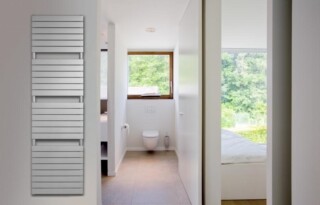Radiators … we just mount them on the wall, right? Yes and no. Yes, most radiators are mounted on the wall, but behind Vasco radiators’ handsome design lurk rather different connection systems. This article details all three systems, explains how they work and lists their drawbacks and benefits.
Connecting your radiators using a one-pipe system
Radiators connected by way of a one-pipe system operate in accordance with the principle of a daisy chain. This means the return water of one radiator serves as the supply water of the next radiator unit. The main drawback of a one-pipe system is that the radiators downstream the line heat up less well than the first unit. So it is important that the entire installation is properly calculated to make sure any heat loss is compensated.
Two-pipe system
Connecting your radiators using a two-pipe system works out more expensively than using the one-pipe system, although it is more efficient. As this particular system uses separate pipes for the supply water and the return water, each radiator operates to the same heat regime.
One-point connection
Finally, you can also fit your Vasco radiators using a one-point connection. This type of connection is chiefly used during renovation works, as it allows modern designer radiators to be connected to existing, ‘old’ central heating pipes. One-point connections can be combined with a one-pipe system or a two-pipe system.
Determining the output your radiators need
If you want to see your radiators work to their full potential, calculating the required heat output for every radiator is a must. After all, every space around your house has different ideal temperatures and not every room has the same dimensions. If you are planning to connect your radiators using a one-pipe system, the supply temperature of your central heating water will be less than average (<75 °C) for most of your radiators, so do not forget to apply a correction coefficient.
